
Even in his years as chancellor, Chang-Lin Tien made time to mentor graduate students and teach mechanical engineering classes. (Photo by Peg Skorpinski/UC Berkeley)
On family road trips across California, Chang-Lin Tien had one important rule:
“If I hear another English word,” he would call to his children, “you all are going to give me a dime.”
It’s not that he was strict, says his daughter, Phyllis Tien ’86, smiling; he just had a dream for his kids and the spirit to see it through.
“My dad always had a lot of pride in his cultural heritage,” says Phyllis Tien. “He always told me how important it is to be able to speak the language and that if you can speak the language, the culture will follow.”
(And, in fact, among her Chinese American friends at the time, it was only Phyllis Tien and her siblings who actually learned Mandarin, she says.)
As chancellor of UC Berkeley throughout the 1990s — the first Asian American to head a major U.S. research university — Tien guided the campus with similar spirit. For Tien, if he could inspire empathy and understanding on campus, he could open Berkeley to a world of international collaboration and friendship.
“I hope the campus becomes more humane — not just with professional excellence but also having a human touch, with everyone more together,” Tien said in an interview for what is now the Library’s Oral History Center. “That’s what I was trying to do during my chancellorship: inject some human touch in this very complex, big campus.”
On a typical stroll through campus, that touch is hard to miss. After Tien’s death in 2002, a group of community members donated in his memory, helping support the campus’s long-standing effort to build a new home for Berkeley’s East Asian materials.
This year, the C. V. Starr East Asian Library, or EAL, and Chang-Lin Tien Center for East Asian Studies celebrates its 10th anniversary. To mark the occasion, EAL has curated an exhibit that showcases the papers of Tien, recently donated by his family, and explores a campus commitment to the study of East Asia nearly as old as the university itself.
The C. V. Starr East Asian Library held a dedication ceremony in late 2007. (Photo by Peg Skorpinski/UC Berkeley)
‘What difference is a building going to make?’
As a graduate student studying classical Chinese, Deborah Rudolph had to do a lot of running.
Before EAL’s new home was envisioned, UC Berkeley’s Chinese, Japanese, and Korean materials were scattered across a patchwork of buildings — from the East Asian Library, in Durant Hall and an annex in California Hall, to the Center for Chinese Studies Library, on Fulton Street (and previously in the basement of Barrows Hall). When Rudolph was a student in the ’80s and ’90s, materials were also stashed on the top floor of the Valley Life Sciences Building.
“Depending on what you were working on, you might have to run down to Barrows, you might have to run over to Biosciences at a particular time of day, you might have to order from NRLF (an off-site shelving facility),” Rudolph says. “You had to run all over campus — a lot.”
Meanwhile, the East Asian Library, in Durant Hall and other locations, was overflowing, as Rudolph recalls. Books were stacked from floor to ceiling, many accessible only with a sliding ladder. “You’d have to be a monkey to use this collection,” a visitor once remarked to Rudolph.
“If you’ve ever lived in a small place, you know, you run out of closet space so you just start cramming things in,” Rudolph says. “The same thing can happen in a library. The more space you have, the better you’re able to take care of the material.”
Faculty members began pushing for a new space in the ’80s — one that could finally unify the campus’s Chinese, Japanese, and Korean materials. In the decades to follow, a band of librarians, faculty, staff, alumni, donors, and volunteers came together to make the vision possible. Tien — one of several chancellors involved in the project — traveled around the world to rally support.
In 2008, the $52 million project came to life, funded completely by donors. It was the first building on the continent built exclusively to house an East Asian collection.
“The whole university got together, really worked together, and pulled it off,” says Peter Zhou, director of the C. V. Starr East Asian Library.
“This is a very special facility — not only for Berkeley, but for academic communities in this country and beyond,” he continues. “It is first-of-a-kind.”
For Rudolph, who is now the curator of EAL’s rare materials, the new building holds the promise that the library’s precious materials can be taken care of. Among the library’s treasures are manuscripts, thousands of woodblock editions, and an oracle bone bearing some of the oldest written Chinese script.
The Fong Yun Wah Rare Book Room contains a book vault with temperature and humidity controls and a security system for extra protection. And because there is classroom space nearby, Rudolph can easily bring visitors from exhibits and classes into the room, inspiring an appreciation for East Asian culture with the community.
“It’s funny — you think, well, the collection hasn’t changed, what difference is a building going to make?” Rudolph says. “But it makes a huge amount of difference.”
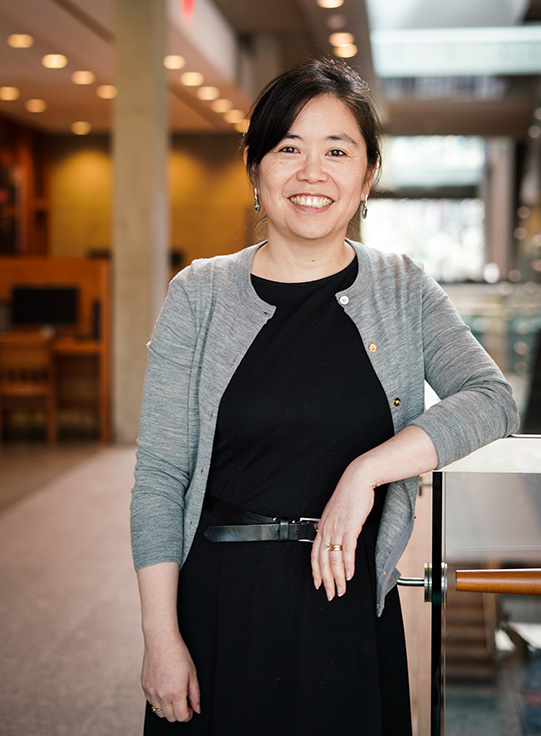
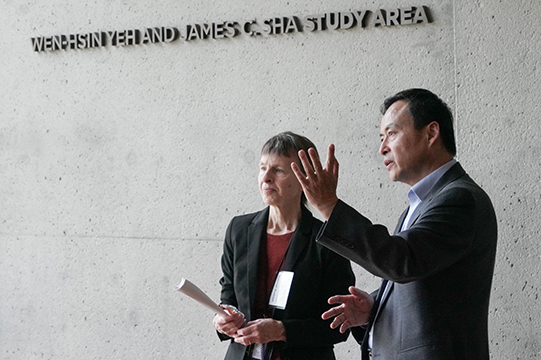

Top to bottom: Clockwise from left: Phyllis Tien ’86 says she’s happy her father’s collection of papers are now at Berkeley; curator Deborah Rudolph, left, and Director Peter Zhou chat in the library; the East Asian Library has study rooms with views of the outdoors. (Photos by Jami Smith and Nic Lehoux for the UC Berkeley Library)
A library personified
To Chancellor Chang-Lin Tien and others, the new library would honor Berkeley’s unique position between East and West, serving as a bridge between California and its neighbors across the Pacific.
For all of his passion for cultural exchange, Tien was, in fact, a mechanical engineer, renowned for his work in microscale heat transfer and thermal insulation. He helped NASA design heat-shielding tiles on its space shuttles and advised scientists on the nuclear reactor meltdown at Three Mile Island in the late ’70s.
After graduate school at Princeton, Tien arrived at Berkeley as an assistant professor in 1959. At 24, he was the youngest person ever hired in the Department of Mechanical Engineering. Only two years later, he became the youngest professor to receive Berkeley’s Distinguished Teaching Award.
The road wasn’t easy, as Tien recounts in his oral history. Tien had a thick Chinese accent and often stumbled over English grammar. So he would tape his lectures in advance, rehearsing the less intelligible parts. His wife, Di-Hwa Tien, would help with typing, and the two would sometimes work until 3 o’clock in the morning.
Tien was a passionate mentor, famous for Friday night pizza parties that doubled as office hours. Even as chancellor, Tien would often sneak back into the lab to advise former students on their work.
“I remember many times, students want to see me urgently,” Tien recalls in his oral history. “I said, ‘The only time I can see you is two o’clock in the morning.’ And they grab it. So I come here at two o’clock.”
“But at eight o’clock a.m., I go to my office,” he continues. “I didn’t want to have anyone accuse me of not really paying full attention to administration.”
As his daughter, Phyllis Tien, puts it: “My dad felt that you should never be limited by labels or how people think you should be when you’re in a certain role. His scientific research group was such an important part of who he was.”
Throughout his career, Tien also served on a dizzying array of international scientific and diplomatic councils and traveled often to Asia to advise on higher education.
Before his trips, Tien would plant himself at various libraries, hungrily studying the cultural and political situations of countries he would visit. In the early ’80s, preparing for a trip to China, Tien visited the Center for Chinese Studies Library daily, exhausting its collection of Chinese newspapers.
“I’d see (Tien) there every day at noon, eating his sandwich,” says Saul Yeung M.S. ’82, then a graduate student who spent untold hours working in the library. “He thought, and read, and ate, for about a half-hour; then he would finish and go.”
At the time, Yeung was studying Communist China, examining the turbulent period following the death of Mao Zedong, head of China’s Communist Party. One day, Tien — who had fled China with his family as a child during the Communist Revolution, settling in Taiwan — noticed Yeung’s research. Tien immediately began mining him for information.
“He was very serious, very curious, very organized,” Yeung recalls. “Every day, he had 10 questions on a small piece of paper he’d bring in. He didn’t write; he would just listen.
“I was wondering, why are you so diligent? This is not your academic field — you’re in science,” Yeung recalls, laughing.
For Yeung, the impact of those interactions have lasted a lifetime. They gave Yeung a vivid example of how to grasp priorities and work with purpose — lessons he impresses on his children and employees to this day.
Inspired by Tien, the family of Saul and Sherry Yeung gave $1 million to honor Tien’s legacy and to help create the C. V. Starr East Asian Library and support its programs.
“Tien is the person who personifies everything we do,” says Peter Zhou, EAL’s director. “Why we’re here, the value of this library and collection, and what is best about Berkeley: academic excellence, global understanding, and commitment to diversity.”
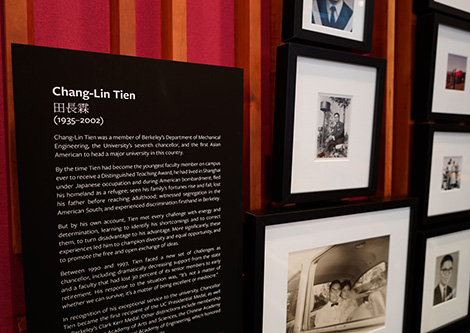

Top to bottom: Left to right: An exhibit of Tien’s papers hangs on the third floor of the East Asian Library. (Photos by Cade Johnson for the UC Berkeley Library)
This year, the Tien family donated a dozen boxes of Tien’s papers to The Bancroft Library — physical souvenirs of those values.
“We love UC Berkeley, and we know it’s going to take care of our dad’s letters,” Phyllis Tien says. “If they were to go anywhere, this is the place.” (All three of Chang-Lin and Di-Hwa Tien’s children graduated from Berkeley.)
The materials — which include Tien’s mechanical engineering papers, lecture notes, photographs, newspaper clippings, congratulatory letters from world leaders, and more — provide a wide-angle snapshot of Tien’s intellectual pursuits and a unique take on one of the campus’s most celebrated supporters.
“I had the privilege of knowing Chang-Lin Tien slightly during his years as chancellor,” says Peter Hanff, Bancroft’s deputy director. “His enthusiasm for the institution and his strong, friendly camaraderie were visible readily enough, but that could not convey his intellectual interests, skills, and accomplishments in ways that his papers do.”
‘The epitome of an idea’
In 1872, University of California co-founder Edward Tompkins declared that it was of “utmost importance” that California educate its students on the languages and literature of East Asia.
That year, Tompkins sold 47 acres of land to fund the university’s first endowed chair: the Agassiz Professorship of Oriental Languages and Literatures. John Fryer, an Englishman who had worked as a translator in China for many years, took up the job. Upon retirement, he donated his personal library — around 2,000 Chinese and English language materials — to the university.
In fact, it was early donations such as Fryer’s that formed the backbone of the East Asian Library, helping it to become one of the most stunning collections of East Asian materials on the continent.
“We want to show that our growth was made possible by gifts,” Zhou says. “They give … to us because they trust us.”
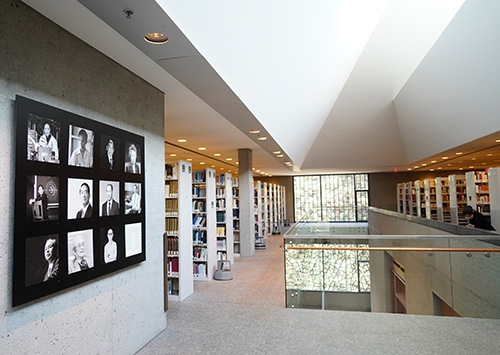
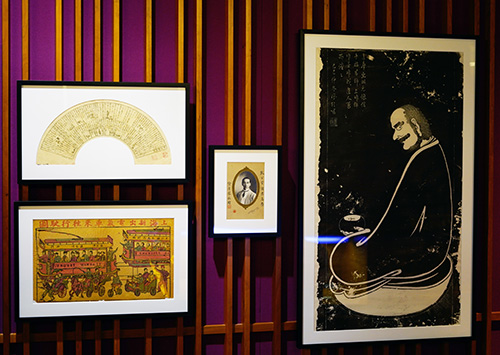
Top to bottom: Left to right: Berkeley alumni are honored on the library’s fourth floor; on a lower floor are favorite items from the collection. (Photos by Cade Johnson for the UC Berkeley Library)
This fall, EAL is mounting a special exhibit to celebrate the building’s 10th anniversary and all the library has accomplished. The exhibit consists of three parts: the Tien papers; a tribute to distinguished alumni of East Asian descent; and rare materials representing 120 years of collecting. Fryer’s papers will be on display, as well as vibrant Korean court paintings and Japanese woodblock illustrations.
The Tien case will include a notebook from his graduate school days, speeches he gave to the community, and photographs of him working with students. There are also insights into the Berkeley Pledge — a passion project of Tien’s aimed at bolstering enrollment of underprivileged youths.
The notable alumni segment will feature students who have gone on to have an impact in the world — a display that, for Zhou, reflects the continued importance of the library and its role in supporting the next generation of leaders.
“This year, the campus is celebrating 150 years of light and history,” Zhou says. “If I can pick one thing that can really epitomize Berkeley’s aspiration through this whole span of time, it is this library.
“It’s the epitome of an idea.”